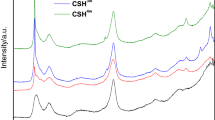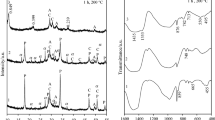Abstract
In this study, calcium silicate hydrate(C–S–H) with CaO/SiO2 ratio of 1.5 target mixture is synthesized and C1.27SH0.76 with 93.4 % purity is obtained. The dried C–S–H was compacted at 8 MPa to 20 mm × 20 mm × 20 mm for accelerated carbonation. The carbonation products and carbonation degree of synthetic calcium silicate hydrate are characterized and quantitatively evaluated by QXRD (Rietveld refinement), mass gain method, and TG/MS analysis. After accelerated carbonation at 0.2 MPa CO2 pressure for 2 h, the carbonation degree from mass gain method is 71.5 %, and from TG/MS analysis is 78.0 %. Calcite, aragonite, vaterite, and amorphous phase exist simultaneously in the accelerated carbonated samples, accounting for 33.98, 17.13, 18.74, and 30.15 %, respectively. Two mass-loss stages were observed for calcium carbonate decomposition. The first mass-loss stage (300–660 °C range) was mainly caused by the decomposition of aragonite and vaterite, and calcite formed in the accelerated carbonation process has a relatively high decomposition temperature which is mainly centered in the 660–800 °C range.





Similar content being viewed by others
References
Diamond S. Cement paste microstructure-an overview at several levels[C]. 1976.
Ciach TD, Gillott JE, Swenson EG, et al. Microstructure of calcium silicate hydrates[J]. Cem Concr Res. 1971;1(1):13–25.
Alizadeh R, Beaudoin JJ, Raki L. Mechanical properties of calcium silicate hydrates[J]. Mater Struct. 2011;44(1):13–28.
Richardson IG. The calcium silicate hydrates[J]. Cem Concr Res. 2008;38(2):137–58.
García-Lodeiro I, Fernández-Jiménez A, Blanco MT, et al. FTIR study of the sol–gel synthesis of cementitious gels: C–S–H and N–A–S–H[J]. J Sol–Gel Sci Techn. 2008;45(1):63–72.
Ibáñez J, Artús L, Cuscó R, et al. Hydration and carbonation of monoclinic C2S and C3S studied by Raman spectroscopy[J]. J Raman Spectrosc. 2007;38(1):61–7.
Black L, Garbev K, Beuchle G, et al. X-ray photoelectron spectroscopic investigation of nanocrystalline calcium silicate hydrates synthesised by reactive milling[J]. Cem Concr Res. 2006;36(6):1023–31.
Black L, Garbev K, Gee I. Surface carbonation of synthetic CSH samples: A comparison between fresh and aged CSH using X-ray photoelectron spectroscopy[J]. Cem Concr Res. 2008;38(6):745–50.
Taylor HF. Cement chemistry[M]. London: Thomas Telford Services Ltd; 1997.
Taplin JH. A method for following the hydration reaction in Portland cement paste[J]. Aust J Appl Sci. 1959;10(3):329–45.
Taylor HF. Proposed structure for calcium silicate hydrate gel[J]. J Am Ceram Soc. 1986;69(6):464–7.
Kantro DL, Brunauer S, Weise CH. Development of surface in the hydration of calcium silicates. II. Extension of investigations to earlier and later stages of hydration[J]. J Phys Chem. 1962;66(10):1804–9.
Seifritz W. CO2 disposal by means of silicates[J]. Nature. 1990;345:486.
Dahlin DC, O’Connor WK, Nilsen DN, et al. A method for permanent CO2 mineral carbonation[R]. Albany: Albany Research Center (ARC); 2000.
Choi Y, Lee H, Hwang J, et al. A preliminary study of CO2 sequestration of cement paste[C]. 2013.
Katsuyama Y, Yamasaki A, Iizuka A, et al. Development of a process for producing high-purity calcium carbonate (CaCO3) from waste cement using pressurized CO2[J]. Environ Prog. 2005;24(2):162–70.
Iizuka A, Fujii M, Yamasaki A, et al. Development of a new CO2 sequestration process utilizing the carbonation of waste cement[J]. Ind Eng Chem Res. 2004;43(24):7880–7.
Teramura S, Isu N, Inagaki K. New building material from waste concrete by carbonation[J]. J Mater Civil Eng. 2000;12(4):288–93.
Morales-Florez V, Findling N, Brunet F. Changes on the nanostructure of cementitius calcium silicate hydrates (C–S–H) induced by aqueous carbonation[J]. J Mater Sci. 2012;47(2):764–71.
Pham ST. Effects of carbonation on the microporosity and macro properties of Portland cement mortar CEM I[J]. J Mater Sci Chem Eng. 2014;2(07):40.
Black L, Breen C, Yarwood J, et al. Structural features of C-S-H(I) and its carbonation in air-a Raman spectroscopic study. Part II: carbonated phases[J]. J Am Ceram Soc. 2007;90(3):908–17.
Morandeau A, Thiery M, Dangla P. Investigation of the carbonation mechanism of CH and CSH in terms of kinetics, microstructure changes and moisture properties[J]. Cem Concrete Res. 2014;56:153–70.
Ye Jiayuan. Study on microstructure characteristics and structure simulation of calcium silicate hydrates[D]. China Building Materials Academy, 2007.
Mojumdar SC, Raki L. Preparation and properties of calcium silicate hydrate-poly (vinyl alcohol) nanocomposite materials[J]. J Therm Anal Calorim. 2005;82(1):89–95.
Junior AN, Toledo Filho RD, Fairbairn EMR, et al. A study of the carbonation profile of cement pastes by thermogravimetry and its effect on the compressive strength [J]. J Therm Anal Calorim. 2014;116(1):69–76.
Kim JJ, Foley EM, Reda Taha MM. Nano-mechanical characterization of synthetic calcium-silicate-hydrate (CSH) with varying CaO/SiO2 mixture ratios[J]. Cem Concr Comp. 2012;36:65–70.
Foley EM, Kim JJ, Reda Taha MM. Synthesis and nano-mechanical characterization of calcium-silicate-hydrate (CSH) made with 1.5 CaO/SiO2 mixture[J]. Cem Concr Res. 2012;42(9):1225–32.
Hidalgo A, Domingo C, Garcia C, et al. Microstructural changes induced in Portland cement-based materials due to natural and supercritical carbonation[J]. J Mater Sci. 2008;43(9):3101–11.
Dweck J, Da Cunha A, Pinto CA, et al. Thermogravimetry on calcined mass basis-hydrated cement phases and pozzolanic activity quantitative analysis[J]. J Therm Anal Calorim. 2009;97(1):85–9.
Sauman Z. Carbonation of porous concrete and its main binding components[J]. Cem Concr Res. 1971;1(6):645–62.
Brecevic L. Solubility of amorphous calcium carbonate [J]. J Cryst Growth. 1989;98(2):504–10.
Acknowledgements
This work was financed by National Natural Science Foundation of China (51172096), the Ministry of education program for New Century Excellent Talents and the Fundamental Research Funds for the Central Universities.
Author information
Authors and Affiliations
Corresponding author
Rights and permissions
About this article
Cite this article
Chang, J., Fang, Y. Quantitative analysis of accelerated carbonation products of the synthetic calcium silicate hydrate(C–S–H) by QXRD and TG/MS. J Therm Anal Calorim 119, 57–62 (2015). https://doi.org/10.1007/s10973-014-4093-8
Received:
Accepted:
Published:
Issue Date:
DOI: https://doi.org/10.1007/s10973-014-4093-8




